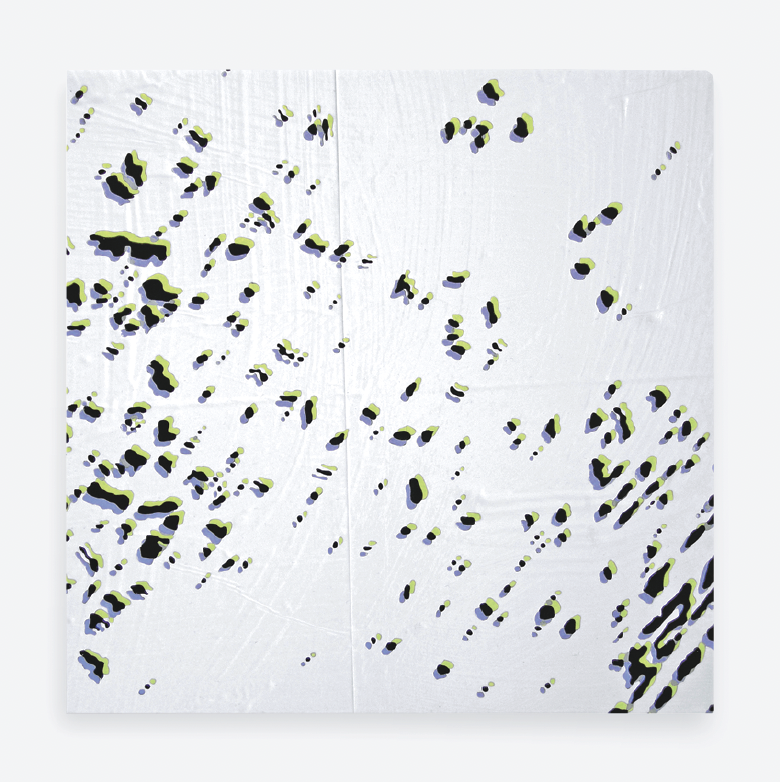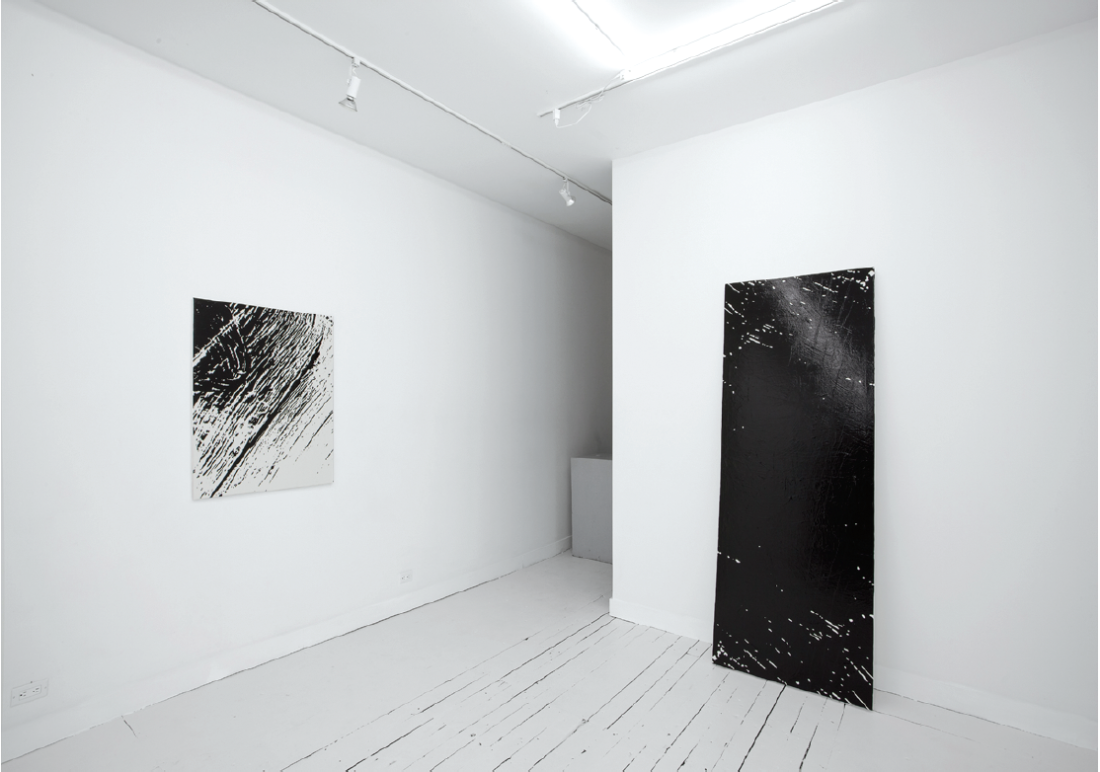Emmy Skensved
Emmy Skensved started exhibiting early, right after her graduation from the OCAD University in 2004. I notice, reading her CV, that I was already writing about her in The Globe and Mail in the summer of 2005 when, during the time of her working for her MFA at the University of Waterloo (2007), she mounted an exhibition called “Killer Valentines” at Toronto’s LE Gallery.
The next year, in 2006, she had a second LE show, this one titled “Luxury Good.” I not only reviewed this exhibition but, violating what some people told me was a rule of good critical practice, I also bought a small work—a severe, rather textile-like or architecturally imbued work (black stripes on white, an enlivening cartouche and a few other restrained flourishes of graphic ornament)—that looked at first like a painting but revealed itself in raking light to be a collage (what the LE Gallery called “the layering of handmade acrylic decals and paint”), the surface luxuriously glazed to the point where the piece began to leave painterliness behind as it moved towards objecthood.
I was drawn to the picture’s apparent lucidity, its full-of-light-ness, but as with all art that richly outlasts one’s initial encounter with it, its clean, crisp, black and white openness soon revealed the presence of procedural complexities and ambiguities that lent to the work a quiet, tasteful kind of destabilizing proto-anarchy. There was, for example, a gentle rain of attenuated droplets of pastel pigment falling down over the surface from above—in highly evolved designer hues of creamy pink, creamy green, creamy grey-mauve—as if the picture were providing its own weather as a soft, alternative, anti-architectural decor. The thing was rife with contradiction.

Emmy Skensved, ColorSync, 2012, acrylic on canvas, 30 x 30 cm. Images courtesy Erin Stump Projects, Toronto.
I followed Skensved’s work for the next few years, losing track of her a bit after she landed a summer internship in Berlin in 2006 to work with Danish artist Kirstine Roepstorff, and then when she finally moved permanently to Berlin a few years later.
Her recent exhibition, “Vis-a-Vis,” at Toronto’s ESP (Erin Stump Projects), offered a welcome chance to view Skensved’s new work and to see if it had evolved from her work of a half-dozen years ago.
In order to house and proclaim the new Skensved exhibition, ESP had become one of the whitest spaces on earth. Not only were the walls and ceiling of the narrow, boxcar-shaped gallery a dazzling, insistently shiny white, but the floor too was white. So white, in fact, that you felt something akin to the spatial anxiety you experience in stepping out onto a floor made of mirror. Just to walk into the gallery was to feel you were somehow polluting it.
The exhibition too was dazzling: very black and very white, and morphologically spartan, or so it seemed at the outset. A cursory glance around the gallery revealed what appeared to be a small selection of highly refined black and white paintings and, leaning against the walls, a number of large, rectangular, frame-like structures and a mostly black, slab-like work on canvas (Double Negative) that, because they seemed to occupy a carefully gauged relation to the paintings, whatever that might turn out to be, worked to reintegrate the exhibition so that it no longer seemed like a show made up of paintings and sculptures yoked together.
What unified the works was, superficially, the blazing whiteness and the stygian blackness of them; but what actually linked everything to everything else was the primacy—the procedural passion—of Skensved’s exceedingly exacting, labour-intensive way of working. As with her work from as far back as 2006 (as already evinced in my little square picture with its “layering of handmade acrylic decals”), you could feel a certain preoccupation with symmetry—now more often referred to by the artist as “doubling”—informing the work.

“Emmy Skensved: Vis-à-Vis,” installation view, Negative Double, 213 x 80 cm, acrylic on canvas, 2012, and Brushstrokes, 100 x 80 cm, 2012. Erin Stump Projects, Toronto. Photography: Jimmy Limit.
What had changed, or at least deepened, since her making of a work like Framework, in 2007, was the increasing complexity, the exactitude of the operations by which she would generate the works. As Skensved’s fellow Berlin-based artist Grégoire Blunt explains it in the “Vis-à-Vis” press release, “Her work is produced through a laborious process of cutting and adhering handmade details onto stretched canvases.” These details, made by brushing acrylic paint onto temporary plastic supports, can eventually be peeled away and repositioned.
I referred a moment ago to the commanding black-and-whiteness of Skensved’s work. This seems initially to be the case—until you look more closely. As Blunt notes, “When viewed from up close, it becomes apparent that every black shape is encircled by yellow and purple halos,” a development of the intrusive fall of decorator pastel “raindrops” in my otherwise severe little Skensved. “These [halos],” Blunt continues, “create vivid optical vibrations and imply a sense [of] spatial depth as the colours look like shadows, suggesting that the black forms are floating above a solid white plane.”
I wouldn’t go so far as to call these outwashes of yellow and purple the stuff of “vivid optical vibrations”—they’re harder to see than that—but they do help to keep Skensved’s cut and applied brush strokes from a sense of fixed adhesion to their supports—canvases or frames—and therefore provide a subtle but insistent kind of resistance to any idea of her objects as emblems of completion, leaving them open to us, rather, as evidence of process.
Because Skensved’s detached brush strokes bear shadows that appear both above and below the black shapes, two different light sources are implied. Which serves, of course, to pop each brush stroke itself away from fixity and into the realm of potential repositioning. It makes for what is almost a ponderously slow kind of animation. And then there is the doubling idea—which lends a further, almost giddy extra-dimensional feeling of incipient vitalism, kineticism, to the work that given the painstaking nature of its production, might be expected to remain earthbound. The fact is that each piece in the exhibition acknowledged a twinned counterpart.
There is an odd, liberating, exhilarating perversity at work here when you consider that—as Gregoire Blunt notes—even when these set-like paired objects are rotated in relation to one another, and despite the images’ being flipped around, the orientation of the shadows remains the same, with yellow on top and purple on the bottom. One part of your certainty about Skensved’s work—the nature and positioning of the manufactured brush strokes—is thus confounded by the location and performance of the recalcitrant shadows the brush strokes cast. Her cunning, maddening decisions set up a sort of moiré effect in the gallery—a beneficent undoing and subsequent aberrant clashing of all the certainties you thought you possessed about the work when you first encountered it. ❚
“Emmy Skensved: Vis-à-Vis” was exhibited at ESP, Toronto, from January 10 to February 17, 2013.
Gary Michael Dault is a critic, poet and painter who lives near Toronto.

